Genre: Pinball Developer: Naxat Publisher: Technosoft Players: 1-2 Released: 1991
This review used the Japanese version of Dragon’s Fury, Devil Crash. For reviewing purposes, both games will be covered by this single article.
I bought Sonic Spinball because it is a Sonic game, Crüe Ball because I like Mötley Crüe and Dino Land because it was in a cheap lot of four games with Puyo Puyo included. But when I decided to purchase Devil Crash MD, also known as Dragon’s Fury outside of Japan, it was because I wanted a good pinball game. Was the purchase completely unnecessary considering I already had three pinball games? Read on!
Devil Crash MD is a port from a PC Engine game called Devil Crash, which was developed by Naxat. There are several other installments in their Crash pinball series, such as Alien Crash and Jaki Crush. While not world famous, they are at least known to be among the best pinball games. Perhaps that is why renowned Japanese developer Tecnosoft decided to port it to the Mega Drive. Tengen handled the western version of the game, which is called Dragon’s Fury, and it was heavily censored.
Since I hate censorship, I bought the Japanese version. I am just glad if my video games turn me into a Jewish Satanist, and by buying Devil Crash MD, all the hexagrams, pentagrams and destroyed coffins with crosses on them influenced me so badly I became a far worse person following a completely wrong religion. For a comparison with the TurboGrafx-16 version, read Joe Redifer’s Side-by-Side article and to read about the whole franchise, check out Hardcore Gaming 101’s article. With that said, I hope you have enough background information for this game, because now I begin with the actual review.
Devil Crash MD plays very much like an actual pinball game, with some additional features helped by the fact that it is a video game. You have three main tables and at the beginning six bonus stages. To reach the sixth bonus stage you turn a girl with a helmet into a dragon. I think the story involves saving this girl in some way, but don’t hold me on that one since I don’t really play pinball games for their stories. Your aim is to reach the bonus stages and defeat the baddies inside of them by hitting them with your ball. When you have beaten the six first bonus stages (it will take a looooong time unless you use an emulator or use cheat codes), two final bonus stages appear. Beat them or get a max score to see the epic ending.
You get to the bonus stages by accomplishing different tasks. Small green arrows point at holes to show you where to aim. Much of it seems very random, but part of the fun is figuring out how you get to them. There are many secret spots and features around the three main tables, which together with the quite hard difficulty gives you many hours of blasting pinball fun to be had before you discover it all. Beating the bonus levels is the most fun and gives you a nice kick. Getting extra balls is very necessary in order to beat all bonus stages. With a password function your score and balls are saved, but not the bonus stages you have beaten.
A flaw is the fact that the game plays a little too much by itself. It can be very hard to reach some spots without pure luck. Sometimes when you lose a ball (especially via the sides), it feels like there was nothing you could do to prevent that. The blazing speed of the ball can be devastating, even at the slowest option.
The graphics have a theme inspired by horror, goth and fantasy. The board is populated by wandering aliens, flame-spitting dragons, skulls and wizards. The art is very well drawn, and the detailed backgrounds help define a classy looking design you won’t find elsewhere. While the colours are a little too bright and weak compared to the 8-bit version, the satanic content and backgrounds make up for it.
The sound is a mixed bag, but part of me still wants to put it in the excellent category. The music was written by Compile composers Toshiaki Sakoda (Musha Aleste) and Masanobu Tsukamoto (Puyo Puyo) and reprogrammed into YM2612 glory by Toshiharu Yamanishi (Thunder Force III, Thunder Force IV and Elemental Master). The compositions themselves are in a timeless land of synthrock with a classical vibe to it. Some are slow, some are fast, most are awsome. Who needs PCM samples when there is FM synthesis? We need them, because the drums and voices are of usual Tecnosoft quality. The PSG sound effects are also very scratchy sometimes, but they more or less work out in general.
Devil Crash MD is slightly flawed on all accounts but is still a superb pinball game and the best one I have played on the console. Considering the genre isn’t as popular as the one where you run around and shoot people, it might just be one of the best ever. If you are impatient or just bad at pinball, you might have a lot of trouble enjoying it, but then the problem lies with you, not the game. If you want a pinball game for your Mega Drive, this should be your primary choice.
SCORE: 8 out of 10

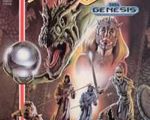
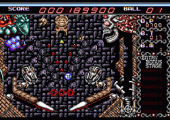
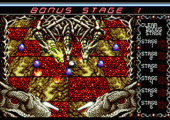
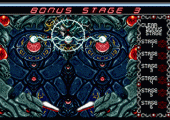
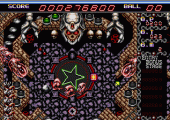
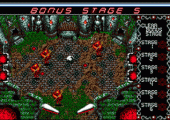
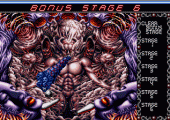
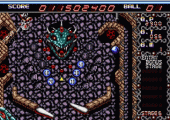
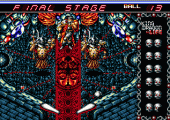
This game is fantastic, but the uncensored Japanese version (Devil Crash MD) is really the way to go.
Possibly the best pinball game ever made me for me, this game is pretty much perfect.